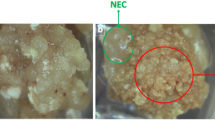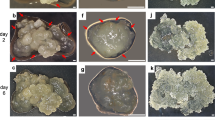Abstract
Different friable Hevea callus lines from the same genotype can display different embryogenic and regenerative potentials. These lines can not be distinguished on the basis of macroscopic criteria. A histological and molecular study was undertaken to characterize the differences existing between five callus lines with different potentials. The genes differentially expressed during induction were analyzed using the differential display (DD-RT) technique. Twenty-eight cDNAs were found to be differentially expressed during induction in the embryogenic regenerating line (ER). Embryogenic nodules were formed earlier in the ER lines than in the embryogenic non-regenerating lines and were completely absent in the non-embryogenic line. Of these 28 cDNAs, five could be used to distinguish between calli prior to induction, thereby enabling an early diagnosis of friable Hevea callus embryogenic potential.




Similar content being viewed by others
Abbreviations
- DD-RT::
-
Differential display technique
- ENR::
-
Embryogenic non-regenerating line
- ER::
-
Embryogenic regenerating line
- NE::
-
Non-regenerating line
References
Alexandrova KS, Conger BV (2002) Isolation of two somatic embryogenesis-related genes from orchardgrass (Dactylis glomerata). Plant Sci 162:301–307
Alschtul SF, Gilsh W, Miller W, Myers EW, Lipman DJ (1990) Basic local alignment search tool. J Mol Biol 215:403–410
Blanc G, Michaux-Ferrière N, Teisson C, Lardet L, Carron MP (1999) Effects of carbohydrate addition on the induction of somatic embryogenesis in Hevea brasiliensis. Plant Cell Tissue Organcult 59:103–112
Carron MP, Enjalric F (1985) Embryogenèse somatique à partir du tégument interne de la graine immature d’Hevea brasiliensis (Kunth., Mull. Arg.). C R Acad Sci Paris 300:653–658
Carron MP, Etienne H, Michaux-Ferrière N, Montoro P (1995a) Somatic embryogenesis in Rubber tree (Hevea brasiliensis Müll. Arg.). In: Bajaj YPS (ed) Biotechnology in agriculture and forestry, vol 30. Somatic embryogenesis and synthetic seed I. Springer, Berlin Heidelberg New York, pp 353–369
Carron MP, Etienne H, Lardet L, Campagna S, Perrin Y, Leconte A, Chaine C (1995b) Somatic embryogenesis in rubber tree (Müll. Arg.). In: Jain S, Gupta P, Newton R (eds) Somatic embryogenesis in woody plants, vol 2. Kluwer, Dordrecht, pp 117–136
Carron MP, Lardet L, Dea BG (1998) Hevea micropropagation by somatic embryogenesis. Plant Recherch Dev 5:187–190
David H, Domon JM, Neutelings G, Dumas B, Meyer Y, David A (1996) Identification of an early marker of embryogenesis in pine. In: Ahuja MR, Boerjan W, Neale DB (eds) Somatic cell genetics and molecular genetics of trees. Kluwer, Dordrecht, pp 29–38
Emons AMC, Kieft H (1991) Histological comparison of single somatic embryos of maize from suspension cultures with somatic embryos attached to callus cells. Plant Cell Rep 10:485–488
Fischer D (1968) Protein staining of ribboned open sections for light microscopy. Histochemie 16:92–96
Franzmann LH, Yoon ES, Meinke DW (1995) Saturating the genetic map of Arabidopsis thaliana with embryonic mutations. Plant J 7:341–350
Haberlandt G (1902) Kulturversuche mit isolierten planzenzellen. Sitzungsber Math Naturwiss Kl Kais Akad Wiss Wien 111:69–92
Hackman I, von Arnold (1985) Plantlet regeneration through somatic embryogenesis in Picea abies (Norway spruce). J Plant Physiol 121:149–158
Jung BK, Pyo JH, Kim WS, Nam BH, Hwang SJ, Hwang B (1998) Cloning of genes specifically expressed in rice embryogenic cells. Mol Cells 8:62–67
Jurgens G, Mayer U, Torres-Ruiz RA, Berleth T, Miséra S (1991) Genetic analysis of pattern formation in the Arabidopsis embryo. Development 1[Suppl 91]:27–38
Jurgens G, Torres Ruiz RA, Berleth T (1994) Embryonic pattern formation in flowering plants. Annu Rev Genet 28:351–371
Kikuchi A, Satoh S, Nakamura N, Fujii T (1995) Differences in pectic polysaccharides between carrot embryogenic and non-embryogenic calli. Plant Cell Rep 14:279–284
Kitamiya E, Suzuki S, Sano T, Nagata T (2000) Isolation of two genes that were induced upon the initiation of somatic embryogenesis on carrot hypocotyls by high concentrations of 2,4-D. Plant Cell Rep 19:551–557
Kiyosue T, Shinozaki KY, Shinozaki K, Higashi K, Satoh S, Kamada H, Harada H (1992) Isolation and characterization of a cDNA that encodes ECP31, an embryogenic-cell protein from carrot. Plant Mol Biol 19:239–249
Kurth J, Varotto C, Pesaresi P, Biehl A, Richly E, Salamini F, Leister D (2002) Gene-sequence-tag expression analyses of 1,800 genes related to chloroplast functions. Planta 215:101–109
Liang P, Pardee AB (1992) Differential display of eucaryotic messenger RNA by means of the polymerase chain reaction. Science 257:967–971
Long JA, Moan EL, Medford JI, Barton MK (1996) A member of the KNOTTED class of homeodomain proteins encoded by the SHOOTMERISTEMLESS gene of Arabidopsis. Nature 379:66–69
Lu P, Porat R, Nadeau JA, O’Neill SD (1996) Identification of a meristem L1 layer-specific gene in Arabidopsis that is expressed during embryonic pattern formation and defines a new class of homeobox genes. Plant Cell 8:2155–2168
Martoja R, Martoja M (1967) Initiation aux techniques de l’histologie animale. Masson et Cie, Paris
Mayer U, Torres-Ruiz R, Berleth T, Miséra S, Jurgens G (1991) Mutations affecting body organization on the Arabidopsis embryo. Nature 353:402–407
Meinke DW (1985) Embryo-lethal mutants of Arabidopsis thaliana: analysis of mutants with ranges of lethal phases. Theor Appl Genet 69:543–552
Montoro P, Pujade-Renaud V, Teinseree N (1997) Strategy to study functionality of putative promoter from Hevea brasiliensis : attempts of Agrobacterium tumefaciens-mediated gene transfer in various tissues. In: Conf Biochem Mol Tools Exploitation Diagnostic Rubber Tree Improv. Bangkok, Thailand, pp 1–7
Mordhorst AP, Toonen MAJ, de Vries SC (1997) Plant embryogenesis. Crit Rev Plant Sci 16:535–576
Neutelings G, Domon JM, Membré N, Bernier F, Meyer Y, David A, David H (1998) Characterization of a germin-like protein gene expressed in somatic and zygotic embryos of pine (Pinus caribaea Morelet). Plant Mol Biol 38:1179–1190
Nuccio ML, Thomas TL (1999) ATS1 and ATS3: two novel embryo-specific genes in Arabidopsis thaliana. Plant Mol Biol 39:1153–1163
Postma-Haarsma AD, Verwoert IGS, Stronk OP, Koster J, Lamers GEM, Hoge JHC, Meijer AH (1999) Characterization of the KNOX class homeobox genesOskn2 and Oskn3 identified in a collection of cDNA libraries covering the early stages of rice embryogenesis. Plant Mol Biol 39:257–271
Pujade-Renaud V, Perrot-Rechenmann C, Chrestin H, Lacrotte R, Guern J (1997) Characterization of a full-length cDNA encoding glutamine synthetase from rubber tree latex. Plant Physiol 35:85–93
Schmidt EDL, Guzzo F, Toonen MAJ, de Vries SC (1997) A leucine-rich repeat containing receptor-like kinase marks somatic plant cells competent to form embryos. Development 124:2049–2062
Steward FC, Mapes MO, Mears K (1958) Growth and organized development of cultured cells. I: Growth and division of freely suspended cells. Am J Bot 45:639–703
Stirn S, Mordhorst AP, Fuchs S, Lorz H (1995) Molecular and biochemical markers for embryogenic potential and regenerative capacity of barley (Hordeum vulgare L.) cell cultures. Plant Sci 106:195–206
Stone SL, Kwong LW, Yee KM, Pelletier J, Lepiniec L, Fischer RL, Goldberg RB, Harada JJ (2001) LEAFY COTYLEDON2 encodes a B3 domain transcription factor that induces embryo development. Proc Natl Acad Sci USA 98:11806–11811
Vries SC De, Booij H, Janssen R, Vogels R, Saris L, LoSchiavo F, Terzi M, van Kammen A (1988) Carrot somatic embryogenesis depends on the phytohormone-controlled expression of correctly glycosylated extracellular proteins. Genes Dev 2:462–467
Wurtele ES, Wang H, Durgerian S, Nikolau BJ, Ulrich TH (1993) Characterization of a gene that is expressed early in somatic embryogenesis of Daucus carota. Plant Physiol 102:303–312
Yadegari R, De Paiva GR, Laux T, Koltunow AM, Apuya N, Zimmerman JL, Fischer RL, Harada JJ, Goldberg RB (1994) Cell differentiation and morphogenesis are uncoupled in Arabidopsis raspberry embryos. Plant Cell 6:1713–1729
Zimmerman JL (1993) Somatic embryogenesis: a model for early development in higher plants. Plant Cell 5:1411–1423
Acknowledgements
We would like to thank Dr. Valérie Pujade-Renaud for supplying the cDNA clone of glutamine synthetase (GS) and Dr. Marie-Françoise Gautier (UMR GACA, INRA-Montpellier) for supplying the cDNA clone of the small subunit of soft wheat rubisco. Our thanks to Jacques Escoute for his assistance and technical supervision of the histology. We would also like to thank Lolita Triaire and Evelyne Dechamp for their technical assistance, and Peter Biggins for the English translation.
Author information
Authors and Affiliations
Corresponding author
Additional information
Communicated by P. Debergh
This work was funded by a grant from the French Ministry of National Education, Research and Technology and also by the Centre de Coopération International en Recherche Agronomique pour le Développement, Département des Cultures Pérennes (CIRAD-CP) at Montpellier-France.
Rights and permissions
About this article
Cite this article
Charbit, E., Legavre, T., Lardet, L. et al. Identification of differentially expressed cDNA sequences and histological characteristics of Hevea brasiliensis calli in relation to their embryogenic and regenerative capacities. Plant Cell Rep 22, 539–548 (2004). https://doi.org/10.1007/s00299-003-0737-z
Received:
Revised:
Accepted:
Published:
Issue Date:
DOI: https://doi.org/10.1007/s00299-003-0737-z




